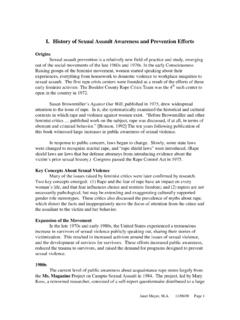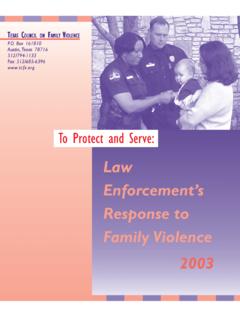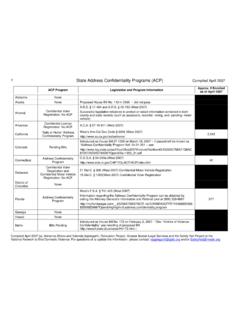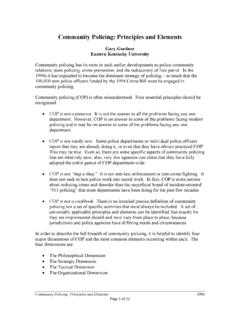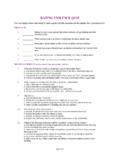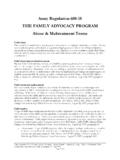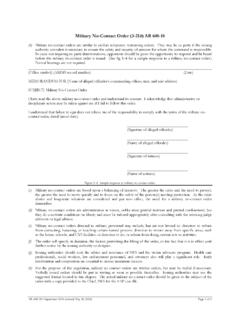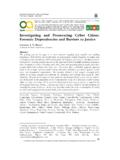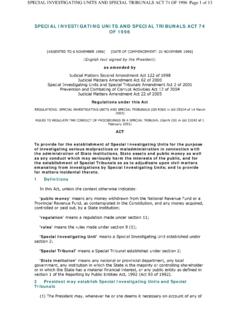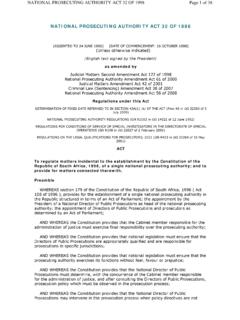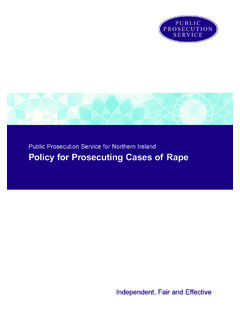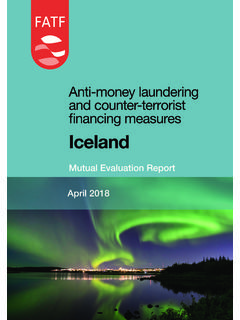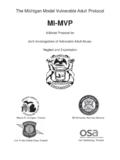Transcription of IACP National Law Enforcement Policy Center
1 I. INTRODUCTIONA. Purpose of DocumentThis paper was developed to accompany the Model Policy onInvestigating Sexual Assaultsdeveloped by the IACP NationalLaw Enforcement Policy Center . The paper provides essentialbackground material and supporting documentation to providea greater understanding of the developmental philosophy andimplementation required for the model Policy . It also addressesfield investigative procedures and best practices for workingwith victims of criminal sexual material isdesigned to assist law Enforcement executives in tailoring themodel Policy to the requirements and circumstances of their owncommunities and BackgroundEstimates of the prevalence of sexual assault in the UnitedStates vary due to differences in data collection, definitions, andcalculations.
2 Based on numbers from the National CrimeVictimization Survey (NCVS), 150 of every 100,0002women ages12 and older were raped or sexually assaulted in 2003,the Federal Bureau of Investigation s (FBI) Uniform CrimeReport4(UCR) statistics indicated a rate of reported forciblerapes per 100,000 adult women. UCR estimates tend to be muchlower for three reasons. First, the UCR data only include inci-dents that are reported to law Enforcement . Second, the UCR def-inition of rape is more restrictive than the NCVS , the NCVS definition is broader, including females ages 12and over, whereas the UCR definition includes only article Making Sense of Rape in America: Where Do theNumbers Come From and What Do They Mean?
3 (2004) explains thataccurate estimates of rape are difficult to obtain because manyrape victims are reluctant to disclose the experience to other peo-ple. Additional factors that hinder an accurate estimationinclude: different ways of defining and measuring rape; differentpopulation groups measured; different time frames; and differentunits of analysis in reporting statistics ( , within a given timeframe, the number of people raped versus the total incidents ofrape).5 Many victim advocates, law Enforcement administrators, andothers have expressed concern about the limited definition ofrape used by the UCR, arguing that it does not present an accu-rate picture of sexual violence in Specifically, the defin-ition used by the FBI for the UCR limits rape to the carnalknowledge of a female, forcibly and against her will.
4 This defi-nition excludes the following types of assaults: Those committed through the delivery of drugs or alcohol tothe victim Those committed against victims who are incapable of con-senting Those that involve anal intercourse, oral copulation, or pen-etration with a foreign object Those committed by female perpetrators or perpetratedagainst male victims Those committed by a blood relative Those perpetrated against child victimsMany argue that such a narrow definition contributes to thestereotype of sexual assault, leaving law Enforcement profession-als ill prepared to respond to the realistic dynamics of to the stereotype of real rape as an assault by astranger committed with a weapon and a great deal of physicalforce, research and law Enforcement experience demonstrate thatthe following represent some of the realistic dynamics of sexualassault crimes: Most sexual assault victims are acquainted with the sus-pect(s) in some way, yet they rarely expected intimacy with thesuspect(s).
5 Many women are victims of repeated rape and sexualassault. Most sexual assaults are not reported to law enforcementauthorities. Men are even less likely to report their sexual assault to thepolice than are women. Victims rarely report to the police first; usually they go firstto a close friend or relative, a health care provider, or a victimadvocate. Victims often delay reporting a sexual assault for days,weeks, months, or even years, and many never disclose it to any-one, including their closest friends. The police are more likely to be notified of sexual assaultsthat are committed by strangers than by someone the victimA publication of the IACP National Law Enforcement Policy Center515 N.
6 Washington St., Alexandria, VA 22314-2357 This document is the result of work performed by the IACP National Law Enforcement Policy Center . The views and opinions expressed in this document are sanctioned by thecenter s advisory board and do not necessarily represent the official position or policies of the International Association of Chiefs of National Law Enforcement Policy CenterInvestigating Sexual AssaultsConcepts and Issues PaperOriginally Published: November 1999 Revised: July 2005knows. Sexual assault perpetrators rarely use weapons and may notuse physical force, relying instead on verbal threats, intimidation,and a victim s vulnerability.
7 Victims emotional reactions mayinclude confusion, shame, and embarrassment. Victims may lie about specifics of the sexual assault becausethey fear that their actions may have contributed to the sexualassault. The trauma of victimization can increase chances for sub-stance abuse, sleeping and/or eating disorders, mental illness,prostitution, suicide, and running away. Few victims are injured to the point that emergency medicalattention is needed. Alcohol and drugs are involved in a high percentage of sex-ual assaults. Individuals who have been previously victimized may beunable to defend themselves due to the past trauma the assaulttriggers and the fear they experience during the current these realities of sexual assault differ dramaticallyfrom the stereotypes held by much of law Enforcement and soci-ety in general, victims are often unwilling to report sexual assaultfor fear of not being believed or because they think they will beblamed for the crime.
8 Victims often fear that their sexual assaultreport will not be believed or taken seriously because: (1) theyknew their assailant; (2) they are related to or closely acquaintedwith the assailant; (3) they are intimidated by the assailant s posi-tion, power, or social status; (4) they engaged in drug or alcoholuse; (5) they put themselves at risk by actions such as entering astranger s automobile or apartment; (6) they have an arrestrecord or an outstanding warrant; or (7) they were engaged inillegal activity at the time of the offense. These same factors thatdeter victims from reporting have been demonstrated to influ-ence the complaint-filing and charging decisions of police small communities and rural areas, many of these problemsare further exacerbated.
9 Victims in these communities often findthemselves at great distances from law Enforcement agencies,social services, and medical care facilities. Because victims in asmaller community may know law Enforcement officers, theymay calculate that it is too difficult to report the crime or call Enforcement professionals must work to help prosecu-tors and jurors understand the behavior of sexual assault victimsand how it differs from the stereotype. If an attack involved nophysical force, police can help explain a victim s submission outof fear by conducting a comprehensive interview in which thevictim describes in detail what she was thinking and feeling dur-ing the assault.
10 If the victim was incapacitated as a result of vol-untary alcohol or drug use, law Enforcement officers can helpshow why this is an issue of increased vulnerabilityrather are a number of improvements that can be made in theinvestigation and prosecution of sexual assault crimes. Althoughsome of these improvements are technological, most are actuallyresults of a thorough police investigation, comprehensive inter-view techniques, and diligent work to establish rapport and trustwith victims. Law Enforcement agencies and investigators needto ensure that sexual assaults involving acquaintances and inti-mate partners are pursued as vigorously as those perpetrated is important to remember that one of the most criticalresponsibilities of the responding officer and investigator is toreassure the victim that he or she will not be judged and that thecomplaint will be taken seriously.
